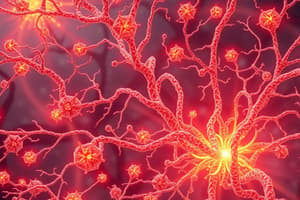Podcast
Questions and Answers
What are nociceptors responsible for detecting?
What are nociceptors responsible for detecting?
- Fine touch and proprioception
- Harmful or potentially harmful stimuli (correct)
- Sensory data primarily from mechanical pressure
- Electrical impulses in the body
Which statement accurately differentiates A-delta fibers from C-fibers?
Which statement accurately differentiates A-delta fibers from C-fibers?
- A-delta fibers transmit pain quickly and are myelinated, while C-fibers transmit pain slowly and are unmyelinated. (correct)
- A-delta fibers transmit dull pain, whereas C-fibers transmit sharp pain.
- C-fibers are responsible for sharp pain while A-delta fibers cause dull pain.
- Both fiber types transmit pain at the same speed.
What does the Gate Control Theory of pain suggest?
What does the Gate Control Theory of pain suggest?
- Pain can only be transmitted through C-fibers.
- Pain signals travel directly to the brain without interference.
- Non-painful stimuli can inhibit painful input at the spinal level. (correct)
- Pain perception is solely dependent on injury severity.
What role do Wide Dynamic Range (WDR) neurons play in pain processing?
What role do Wide Dynamic Range (WDR) neurons play in pain processing?
According to the Neuromatrix Theory, how is pain experienced?
According to the Neuromatrix Theory, how is pain experienced?
How does the CNS modulate pain signals through descending pathways?
How does the CNS modulate pain signals through descending pathways?
What is the function of the Substantia Gelatinosa (SG) neurons in pain processing?
What is the function of the Substantia Gelatinosa (SG) neurons in pain processing?
What type of stimuli do C-fibers primarily convey?
What type of stimuli do C-fibers primarily convey?
Flashcards are hidden until you start studying
Study Notes
Nociceptors
- Specialized sensory neurons detecting harmful stimuli, including extreme temperatures, pressure, and chemical irritants.
- Initiate the pain response to alert the body to potential harm.
A-delta fibers vs C-fibers
- A-delta fibers: Myelinated neurons that transmit sharp, localized pain rapidly.
- C-fibers: Unmyelinated neurons conveying slower, diffuse, aching pain.
Gate Control Theory of Pain
- Theory proposing that non-painful stimuli can close spinal "gates," reducing pain perception.
- Involves interaction between various sensory fibers and inhibitory interneurons.
Role of Wide Dynamic Range (WDR) Neurons
- Located in the spinal cord, WDR neurons respond to both noxious and non-noxious stimuli.
- Critical for integrating sensory information and modulating the pain response.
Neuromatrix Theory of Pain
- Suggests that pain experience arises from a brain network, termed "neuromatrix."
- Integrates sensory, emotional, and cognitive information, creating a multidimensional pain experience.
CNS Pain Modulation via Descending Pathways
- The Central Nervous System can amplify or suppress pain signals through descending pathways.
- Modulation influenced by emotional state, attention, and the opioid system's involvement.
Function of Substantia Gelatinosa (SG) Neurons
- SG neurons, found in the spinal cord, are key in "gate control" mechanisms for pain processing.
- Help determine the transmission of pain signals to higher brain centers.
Significance of the Thalamus in Pain Perception
- Serves as a relay station for processed pain signals from the spinal cord.
- Distributes these signals to various brain regions, essential for the perception and emotional response to pain.
Studying That Suits You
Use AI to generate personalized quizzes and flashcards to suit your learning preferences.




